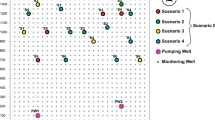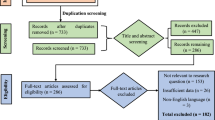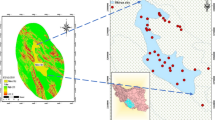Abstract
This research aims at optimizing the monitoring network used to consistently identify pollution’s origin in the pollution source identification problem in groundwater hydraulics under real-time/operational applications. For this task, Machine Learning (ML) and Deep Learning (DL) methods are introduced, which can outperform metaheuristics, such as Genetic Algorithms (GAs), in terms of total computational load. To test the approach, a theoretical aquifer with two pumping wells is studied, where one of six possible pollution sources may spread a conservative pollutant. An existing own software simulates a 2D surrogate steady state flow field, using particle tracking to simulate advective mass transport only. A large number of combinations of possible source locations (4 different layout scenarios), hydraulic gradients and pumping wells’ flow-rates is used to calculate various features (such as pollutant arrival times, hydraulic drawdowns) in a 29 × 29 grid. Three ML/DL methods (Random Forests, Multi-Layer Perceptron, Convolutional Neural Networks) are tested for prediction accuracy, while Correlation based Feature Selection (CFS), and targeted tests are used to select subsets/sampling frequencies that can provide similar accuracy with the full datasets. This evaluation process bears promising results and paves the way for monitoring network optimization.
Access this chapter
Tax calculation will be finalised at checkout
Purchases are for personal use only
Similar content being viewed by others

References
Kontos, Y., Katsifarakis, K.: Optimization of management of polluted fractured aquifers using genetic algorithms. Eur. Water 40, 31–42 (2012)
Kontos, Y., Katsifarakis, K.: Optimal management of a theoretical coastal aquifer with combined pollution and salinization problems, using Genetic Algorithms. Energy 136, 32–44 (2017)
European Parliament and Council: Directive 2004/35/CE of the E.P. and E.C. of 21-4-2004 on environmental liability with regard to the prevention and remedying of environmental damage, OJ L 143, 30.4.2004, pp. 56–75 (current version 26/06/2019) (2004)
Han, K., et al.: Application of a genetic algorithm to groundwater pollution source identification. J. Hydrol. 589, 125343 (2020)
Mo, S., Zabaras, N., Shi, X., Wu, J.: Deep autoregressive neural networks for high-dimensional inverse problems in groundwater contaminant source identification. Water Resour. Res. 55(5), 3856–3881 (2019)
Shen, C.: A transdisciplinary review of deep learning research and its relevance for water resources scientists. Water Resour. Res. 54(11), 8558–8593 (2018)
Zhang, J., Zheng, Q., Chen, D., Wu, L., Zeng, L.: Surrogate‐based Bayesian inverse modeling of the hydrological system: an adaptive approach considering surrogate approximation error. Water Resour. Res. 56(1), 1–25 (2020). https://doi.org/10.1029/2019WR025721
Janardhanan, S., et al.: Optimal design and prediction-independent verification of groundwater monitoring network. Water 12(1), 123 (2020)
Bagkis, E., Kassandros, T., Karteris, M., Karteris, A., Karatzas, K.: Analyzing and improving the performance of a particulate matter low cost air quality monitoring device. Atmosphere 12(2), 251 (2021)
Anderson, M., Woessner, W., Hunt, R.: Particle tracking, Chap. 8. In: Anderson, M., Woessner, W., Hunt, R. (eds.) Applied Groundwater Modeling, 2nd edn., pp. 331–373. Academic Press, San Diego (2015)
Shimrat, M.: Algorithm 112: position of point relative to polygon. Commun. ACM 5(8), 434 (1962)
Breiman, L.: Random Forests. Mach. Learn. 45, 5–32 (2001)
McCulloch, W., Pitts, W.: A logical calculus of the ideas immanent in nervous activity. Bull. Math. Biol. 5, 115–133 (1943)
Frank, E., Hall, M., Witten, I.: The WEKA workbench. Online Appendix for “Data Mining: Practical Machine Learning Tools and Techniques”, 4th edn. Morgan Kaufmann (2016)
Hall, M.: Correlation-based feature selection for machine learning. Ph.D. Thesis, Department of Computer Science, University of Waikato Hamilton (2000)
Bisong, E.: Google Colaboratory, Building Machine and Deep Learning Models on Google Cloud Platform: A Comprehensive Guide for Beginners, pp. 59–64. Apress, Berkeley (2019)
Ronneberger, O., Fischer, P., Brox, T.: U-Net: convolutional networks for biomedical image segmentation. In: Navab, N., Hornegger, J., Wells, W.M., Frangi, A.F. (eds.) MICCAI 2015. LNCS, vol. 9351, pp. 234–241. Springer, Cham (2015). https://doi.org/10.1007/978-3-319-24574-4_28
Acknowledgments
This research is co-financed by Greece and the European Union (European Social Fund- ESF) through the Operational Programme «Human Re-sources Development, Education and Lifelong Learning 2014-20» in the context of the project “Evolution of Computational Intelligence in Environmental Engineering-Generalization, Improvement, Optimal Combination of Methodologies in Air Quality & Water Resources Problems” (MIS 5052163).
Author information
Authors and Affiliations
Corresponding author
Editor information
Editors and Affiliations
Rights and permissions
Copyright information
© 2021 The Author(s), under exclusive license to Springer Nature Switzerland AG
About this paper
Cite this paper
Kontos, Y.N., Kassandros, T., Katsifarakis, K.L., Karatzas, K. (2021). Deep Learning Modeling of Groundwater Pollution Sources. In: Iliadis, L., Macintyre, J., Jayne, C., Pimenidis, E. (eds) Proceedings of the 22nd Engineering Applications of Neural Networks Conference. EANN 2021. Proceedings of the International Neural Networks Society, vol 3. Springer, Cham. https://doi.org/10.1007/978-3-030-80568-5_14
Download citation
DOI: https://doi.org/10.1007/978-3-030-80568-5_14
Published:
Publisher Name: Springer, Cham
Print ISBN: 978-3-030-80567-8
Online ISBN: 978-3-030-80568-5
eBook Packages: Intelligent Technologies and RoboticsIntelligent Technologies and Robotics (R0)



